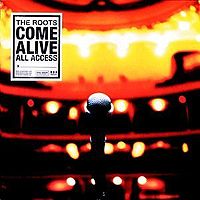
The Roots
The Roots Come Alive
[MCA/Universal; 2000]
These days, The Roots are widely considered the best band on late night TV. Yet in the 1990s, the Philadelphia septet earned its chops on the road, performing some 200 shows per year while finding time to record studio material. That formula worked well for the band, despite its turbulent schedule: 1996’s illadelph halflife and 1999’s Things Fall Apart are hip-hop classics in the eyes of many, their left-of-center sonic approach championed by backpackers and shiny suits alike.
Still, you couldn’t truly appreciate The Roots until you saw them live — the solos in which ?uestlove would play drums with his hands, the deafening bass drops Hub would inflict upon the crowd, the captivating beatbox battles between Rahzel and Scratch. Released in November 1999, The Roots Come Alive was ambitious and controlled, as it sequenced the group’s best performances into one coherent set. There was the volcanic “Step Into The Realm” on which vocalist Black Thought vacillated between whispers and full-throated rhymes, and the vigorous call-and-response of “The Ultimate.” While both songs were recorded in different time zones, they felt like a part of the same show. Then there was “You Got Me,” with its frenzied percussion and vocal scratches. The nine-minute closer would serve two purposes: it was the album’s centerpiece, and it introduced to the world an unknown singer named Jill Scott. In subsequent years, The Roots would expand their live set to include more pop and alt-rock influences. The Roots Come Alive is a remarkable glimpse into the band’s evolution, long before Jimmy Fallon wisely came knocking.
– Marcus J. Moore
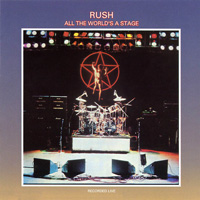
Rush
All The World’s A Stage
[Anthem/Mercury; 1976]
No matter what era they’re in, or what musical style they’re attaching themselves to you can count on one thing with Rush – they’re going to nail it live. There are probably testimonials out there of people who hated Power Windows, but saw them on that tour and loved it. Playing well live is their constant. However, as time goes on and they use more and more instruments on an album, there’s an even heavier reliance on sorcery and tricks to fill that sound out in an arena (see: “Far Cry” live on the Snakes and Arrows Tour).
Not with All The World’s A Stage though. This Rush live album is a feral beast, full of rawness and fury. Hearing Lee, Lifeson and Peart coming together and creating all that noise and power while staying almost note perfect with just one guitar, one bass and one (rather large) drum kit is something to behold and enjoy; “2112” never sounded so good! All The World’s A Stage is, most certainly, the thinking man’s sweaty and energetic live album.
– Daniel Griffiths

Sigur Rós
Inni
[XL; 2011]
Icelandic quartet Sigur Rós are easily one of the more renowned international acts around. With that said, they’re also probably one of the more difficult bands to catch live since they rarely tour and typically tend to sell out shows rather quickly when they do. Inni is closest thing to catching them live, as it definitively captures both visual and audio aspects of their live performance. There is a difference between this particular live recording and their studio recorded albums – they’re without the strings section provided by band Amiina. But it doesn’t take away from their performance; think of it as addition by subtraction.
Some may think that without the strings, there’s a void. But the band fills it with thick layers of ambient soundscape, reverberated guitars (at times, played with a cello bow), explosive percussion from Orri Páll Dýrason, and Jónsi’s signature falsetto. Bassist Georg Hólm is also highlight as the bass cuts clearly through these dense layers. Songs like “Svefn-g-englar,” “Ný Batterí,” and “E-Bow” are already grandeur in sound. And no matter how familiar those songs are, they sound even more epic and expansive live.
Clocking in at over 100 minutes, the live tracks span over two discs that include a 15-minute version of “Popplagið” and a new song “Lúppulagið,” which is a six-minute excursion of chilling ambient piano melodies that are full of elegance and grace. It’s as if the band is taking the audience through their native homeland. Inni perfectly captures Sigur Rós at their core: a performance that showcases strictly the main band members and their uncanny ability to leave spectators awestruck through sheer musicianship.
– Ace Ubas

Talking Heads
The Name of This Band is Talking Heads
[Sire; 1982]
David Byrne introduces: “The name of this song is ‘New Feeling.’ That’s what it’s about.”
Boom, you’re in their world now, a force-filled advent of grooving guitars and allied, spontaneous perfection. Few bands have left such a resounding impression on me as Talking Heads. With staple albums like Remain in Light, More Songs About Buildings And Food, and Fear of Music taken into consideration, the culmination of these records into a live format succeeds greater than a chunk of their own studio recordings. “Pulled Up” is grounded and nearly flawless instrumentation, but the build and to the communal repetition of the chorus hits harder each time and “Psycho Killer” is reworked to all hell where Byrne substitutes some lyrics during a nearly-full verse.
The 2004 reissue of this album also introduced twice the amount of material on the original 1982 release, such as “I’m Not In Love,” “Warning Sign,” and “Born Under the Punches (The Heat Goes On),” making it the default go-to for crisp Talking Heads live material (seriously, the sound quality is astounding) and essentially a time capsule of one of the world’s greatest New Wave bands. It feels as close to a Talking Heads show as you can possibly get, and there isn’t much else I could realistically desire for any live album.
– Andrew Halverson

Tom Lehrer
An Evening Wasted With Tom Lehrer / Revisited / That Was The Year That Was
[Reprise/Warner Bros.; 1959, 1960, 1965]
Arguing the case that Tom Lehrer’s live content is better than his two studio albums is pretty easy; Lehrer is an exceptionally charming performer, and anything additional to his songs is an instant bonus. In actual fact, the introductions and occasional “outro-ductions” (as Lehrer might have put it himself) are the only things that make the songs different. And Lehrer has no shame in admitting this; the back cover of Revisted reads:
“Although we have tried, by using a different cover, to delude you into thinking otherwise, this record contains exactly the same songs as on the 10” LP SONGS BY TOM LEHRER. This one, though, has been padded out with Mr. Lehrer’s allegedly droll commentary on the songs as well as some rather cloying audience reaction. These additions are quite unnecessary, but enable us to charge more.”
And so goes the unflappable and consistent satire of Lehrer, who can create laughter without the aid of his trusty piano and his “twelve incredibly agile fingers.” His spoken word segments on his first two live albums make them an utter pleasure to return to (along with the lastly enjoyable songs too, of course).
That Was The Year That Was, however, might be a cut above the others not just for the fact that it presents us with material performed by Lehrer that never made it to the studio, but also the fact that there’s some of his best songs here. I actually only bought the album myself a month or two back, but near enough every day I listen to it, and it never fails to amuse me and make me smile. Not only are his songs just good for their musical proficiency, the fact that they still sound relevant today adds to the superlatives the fact that his best songs are timeless – both in regards to their subject matter, and for their comical value.
– Ray Finlayson
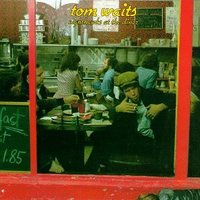
Tom Waits
Nighthawks at the Diner
[Asylum; 1975]
If you read any recent interviews with Tom Waits, you consistently get the impression that he’s this wonderfully witty, world-weary artist who has a story for everything. And even though I’ve never met Mr. Waits, I am of the firm belief that he is actually like this. But I also believe that he was always this charming, funny, and interestingly entertaining. The evidence for this comes from his third official album — and first live outing put to record — Nighthawks At The Diner, where Waits spins yarns about the terrible coffee in L.A. diners and spending an evening in the company of yourself.
The album showcases Waits’ natural ability to pluck wonderful words from nowhere and go on to create some brilliant evocative imagery (“A yellow biscuit of buttery cue ball moon” being one of my personal favourites) along with highlighting his great storytelling skills, like on “Putnam County” or his cover of “Big Joe & Phantom 309.” His music is loose and baggy, but has a fundamental jazz core (mainly due to the expert players on stage with him), which matches Waits’ freewheeling poetic verses on “Nighthawk Postcards (From Easy Street).” And ultimately it gives us a picture of a much younger Waits (it was recorded and released nearly forty years ago), showing us that has always been as masterfully odd as we see him today.
– Ray Finlayson
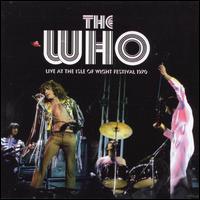
The Who
Live At The Isle of Wight Festival 1970
[Columbia/Legacy; 1970]
Live at Leeds is, of course, the iconic live release from The Who, and while the original six-song version is hard to top, I’ve always been partial to this set over any of the expanded Leeds reissues. It’s got a ferocious, more-or-less-complete version of Tommy, which always worked better live than on record; all their usual staples of the time (“Heaven and Hell,” “Young Man Blues,” “My Generation”); and, most significantly, some phenomenal Lifehouse songs that were ultimately left off Who’s Next.
– Sean Highkin
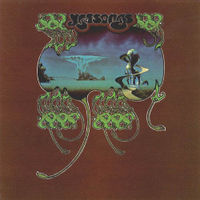
Yes
Yessongs
[Atlantic; 1973]
Prog rock never had a higher peak than the two years during which Yes released The Yes Album, Fragile, and Close to the Edge. This triple-LP set, released in 1973, is an appropriately over-the-top document of the tour that supported the latter of those albums. The group flawlessly recreates their studio compositions onstage, no small feat as these are some of the most layered, complex studio creations of their time. Drummer Alan White joined the group during this tour when Bill Bruford left Yes to join King Crimson, and most of the selections on Yessongs feature White. However, the highlight belongs to Bruford, whose solo in the underrated Yes Album cut “Perpetual Change” kills. Yessongs is as good an introduction as any to classic-era Yes. Get it on vinyl if you can–Roger Dean’s triple-gatefold sleeve is just as gloriously epic as the music.
– Sean Highkin

